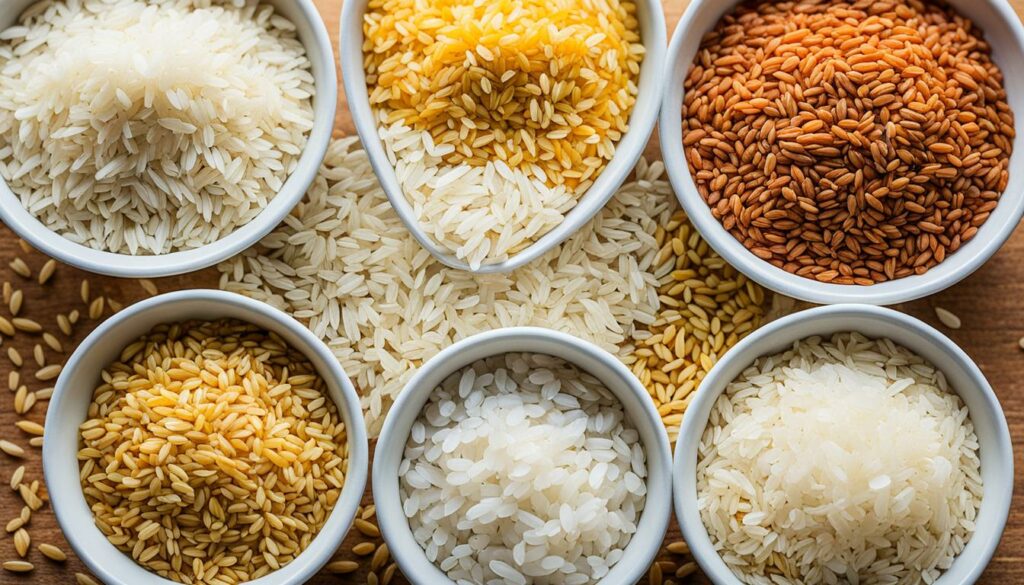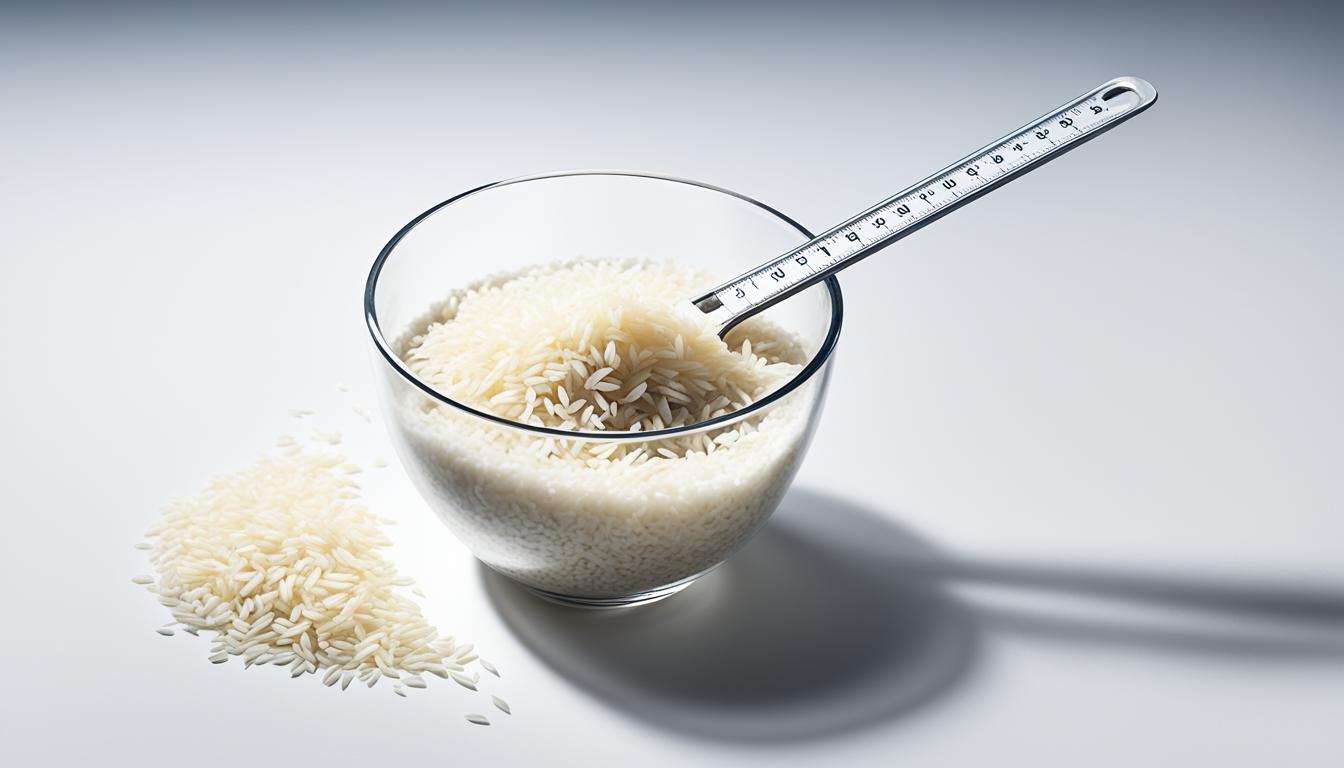How Much Dry Rice Does ¼ Cup Make? Easy Guide
Have you ever wondered how much-cooked rice you can expect to yield from just 1/4 cup of uncooked rice? It seems like a simple enough question, but the answer can be anything but straightforward. Whether you’re a seasoned home cook or just starting, understanding the conversion of dry rice to cooked rice is essential for perfecting your rice dishes.
This comprehensive guide will unravel the mysteries of rice measurement and volume conversion. From exploring different rice measurement units to delving into the impact of rice type on overall yield, we will arm you with the knowledge you need to measure and cook rice confidently.
But first, let’s address the burning question: how much dry rice does ¼ Cup make? Prepare to discover the answer and gain valuable insights into rice serving sizes, cooking measurements, and more.
The Basics of Rice Measurement
Rice Measurement Units: Volume vs. Weight
Rice can be measured using two common units: volume and weight. Volume measurement involves using cups or spoons to determine the quantity of rice.
On the other hand, weight measurement requires a kitchen scale to measure the exact weight of the rice. Each unit has advantages and relevance in rice cooking, depending on the specific recipe and desired outcome.
Standard Rice to Water Ratios
The rice-to-water ratio is crucial for achieving perfectly cooked rice. The general rule of thumb is to use a specific amount of water for every Cup of rice. This ratio may vary slightly depending on the type of rice.
For example, long-grain rice typically requires 2 cups of water for 1 cup of rice, while short-grain rice may need a little more water to achieve the desired texture.
Impact of Rice Type on Volume Conversion
The type of rice used can also impact the volume conversion when cooking. Different rice varieties have unique characteristics that affect their density and absorbency.
For example, while 1 cup of long-grain rice may yield a specific volume of cooked rice, the exact measurement of specialty rice like Basmati or Jasmine may result in a different volume.
It’s essential to consider the specific rice type when determining the expected conversion from dry to cooked rice.
How Much Dry Rice Does ¼ Cup Make?
We understand that measuring rice accurately is essential for meal preparation, and knowing the serving size implications can help plan a balanced meal. Let’s dive in and find out!
Variations in Rice Type and Cooking Outcome
Different types of rice have varying cooking outcomes and yields, making it essential to understand their characteristics and cooking properties. This knowledge helps determine the expected yield when cooking different types of rice.
White Rice: The Basic Staple
White rice is the most common and widely consumed variety. It has a neutral flavor and a soft, fluffy texture. White rice is versatile and pairs well with various dishes, making it a staple in many cuisines.
Brown Rice: Nutritious and Dense
Brown rice is a whole grain known for its nutty flavor and chewy texture. It retains the bran and germ layers, making it fiber, vitamins, and minerals higher than white rice. Due to its denser composition, brown rice requires longer cooking time and more water to achieve the desired tenderness.
Specialty Rices: Basmati and Jasmine
Basmati and jasmine rice are famous specialty rice for their distinctive aromas and flavors. Basmati rice has a fragrant, nutty taste, while jasmine rice has a delicate floral aroma. Both varieties have elongated grains and a slightly sticky texture when cooked. They are commonly used in Asian and Middle Eastern cuisines.
Wild Rice: An Exception to Standard Yields
Wild rice is not technically a rice but native North American aquatic grass. It has a unique appearance with long, dark grains that are chewy in texture and have a nutty flavor. Wild rice requires a longer cooking time, and the yield can be less compared to other types of rice, so it’s essential to adjust cooking ratios and times accordingly.

Ideal Cooking Methods for Perfect Rice
Whether you prefer the traditional stovetop cooking method, the convenience and precision of rice cookers, or alternative methods like steaming or oven cooking, there is a technique that suits your preference and yields delicious results.
Stovetop Cooking for Traditionalists
Stovetop cooking is a classic method that many rice enthusiasts prefer. It allows for more control over the cooking process and develops a beautiful crust on the bottom layer of rice, known as “tahdig” in Persian cuisine.
To cook rice on the stovetop, follow the recommended rice-to-water ratio: Bring the water to a boil, add the rice, reduce the heat, and simmer until the rice is cooked to perfection.
Rice Cookers: Convenience and Precision
Rice cookers have become popular due to their convenience and precise cooking capabilities. These electronic appliances automate the cooking process, ensuring that the rice is always cooked to perfection.
Add the rice and water to the rice cooker, select the appropriate settings, and let the machine do the work. Rice cookers are especially convenient for busy individuals or those who want consistent results without having to monitor the cooking process closely.
Alternative Methods: Steaming and Oven Cooking
If you’re looking to explore alternative cooking methods for rice, steaming and oven cooking are excellent options. Steaming rice involves placing a steamer basket over a pot of boiling water and allowing the steam to cook the rice to fluffy perfection.
This method is particularly popular for sticky rice varieties. On the other hand, oven cooking involves baking the rice in a covered oven-safe dish. This method allows for even heat distribution and yields a slightly drier and fluffier texture than stovetop cooking.
Experimenting with different cooking methods can help you find the ideal technique that suits your taste preferences and desired texture. Whether you prefer the traditional stovetop method, the convenience of rice cookers, or the uniqueness of alternative methods like steaming or oven cooking, the key is to enjoy the process and savor the delightful outcome of perfectly cooked rice.
Rice Cooking Tips for the Perfect Texture
Here are a few essential tips when cooking rice to achieve the perfect texture. This section will discuss three critical rice cooking tips to help elevate your rice dishes to new heights.
Pre-cooking Rinse: Removing Starch for Fluffy Rice
A pre-cooking rinse is a simple but effective technique for improving the texture of your cooked rice. By rinsing the rice before cooking, you remove excess starch that can cause the grains to clump together. Rinse the rice under cold water until the water runs clear, ensuring all the starch is washed away. This step will result in lighter, fluffier rice that separates easily.
Water Quantities: Achieving the Perfect Consistency
The amount of water you use when cooking rice is crucial to perfect consistency. The general rule of thumb is to use a 1:2 ratio of rice to water. However, different types of rice may require slight adjustments.
For example, long-grain rice may require more water, while short-grain rice may need slightly less. It’s essential to follow the cooking instructions for the specific type of rice you are using and make adjustments as needed.
The Secret to Resting Rice Post-Cooking
Resting the rice after it has finished cooking is a secret technique many professional chefs use. Allowing the rice to rest for a few minutes with the lid on before serving helps it reach its full potential in terms of texture and flavor.
The steam circulates within the pot during this resting period, evenly distributing moisture throughout the rice. As a result, you get perfectly cooked rice with a delightful, fluffy texture.
The Rice-to-Water Ratio: A Critical Cooking Component
The rice-to-water ratio is a crucial aspect of rice cooking that directly influences the outcome of your prepared dish. Achieving the perfect balance between rice and water is essential for obtaining fluffy and well-cooked grains.
Tweaking the Ratio for Different Rice Types
It is important to note that different types of rice may require slight adjustments to the standard rice-to-water ratio. For example, short-grain rice tends to absorb more water than long-grain varieties.
Therefore, when cooking short-grain rice, you may need to increase the water quantity slightly to achieve the desired texture. Conversely, when cooking long-grain rice, you may need to decrease the water quantity to prevent the grains from becoming mushy.
The Importance of a Consistent Measuring Method
It is crucial to adopt a consistent measuring method to ensure accurate results when measuring rice and water.
Using the same measuring Cup or spoon every time you cook will help you maintain consistency in the rice-to-water ratio. This consistency is key to achieving consistent results in terms of texture and doneness.
Adjusting for Altitude and Cooking Vessels
In addition to rice type and consistent measuring, other factors such as altitude and the type of cooking vessel used can also affect the rice-to-water ratio. At higher altitudes, where water boils at a lower temperature, you may need to increase the water quantity slightly to compensate for the lower boiling point.
Similarly, the type of cooking vessel used, whether a saucepan, rice cooker or pressure cooker, may require adjustments to the rice-to-water ratio to account for variations in heat distribution and evaporation rates.
Understanding Rice Portions and Dietary Considerations
Calculating serving sizes based on individual needs is critical to achieving weight management, meeting specific nutritional goals, or simply maintaining a balanced diet.
Calculating Serving Sizes for Individual Needs
The ideal serving size of rice can vary depending on age, gender, activity level, and overall caloric intake. As a general guideline, a standard serving of cooked rice is about 1/2 to 1 cup. However, it’s essential to tailor this portion to your specific needs. If you’re following a weight loss or weight maintenance plan, consulting with a registered dietitian or nutritionist may be beneficial to determine the appropriate serving sizes for you.
Nutritional Values: Balancing Calories and Carbohydrates
Considering rice’s nutritional values is crucial for maintaining a balanced diet. Rice is a rich source of carbohydrates, providing energy for the body. However, as rice can be calorie-dense, it’s essential to balance and be mindful of calorie intake.
Opt for whole grain varieties like brown rice or wild rice, which offer more fiber and nutrients than white rice. Balancing calorie intake and carbohydrates from rice with other food groups can help ensure a well-rounded diet.
In addition to carbohydrates, rice contains a small amount of protein and fat. It’s worth noting that these macronutrients exist in higher amounts in rice bran and the outer layers of whole-grain rice. While the protein content in rice is not as high as that in animal-based foods or legumes, it can still contribute to overall protein intake.
FAQ
Q: How much dry rice does ¼ Cup make?
A: 1/4 cup of dry rice usually yields about 1/2 to 3/4 cup of cooked rice, depending on the type of rice and cooking method.
Q: How do you measure dry rice?
A: Dry rice can be measured using either volume measurement, using measuring cups or spoons, or weight measurement, using a kitchen scale.
Q: What is the standard rice-to-water ratio?
A: The standard rice-to-water ratio is usually 1 part rice to 2 parts water, but this can vary depending on the type of cooked rice.
Q: How does the type of rice impact volume conversion?
A: Different types of rice have varying cooking outcomes and yields. Some types, like Basmati or Jasmine, may yield more cooked rice.
Q: What are the characteristics of white rice?
A: White rice is an essential staple with a mild flavor and a fluffy texture when cooked. It is widely used in many cuisines around the world.
Q: How does brown rice differ from white rice?
A: Brown rice is more nutritious and has a chewier texture than white rice. It retains the bran layer, which gives it a nuttier flavor.
Q: What are specialty rice like Basmati and Jasmine?
A: Basmati and Jasmine are aromatic rice with distinct flavors and long grains. They are commonly used in Asian and Middle Eastern dishes.
Q: How does wild rice differ from other types of rice?
A: Wild rice is not rice but a type of aquatic grass. It has a nutty flavor and chewy texture, and the cooking time is longer than other rice types.
Q: What are the ideal cooking methods for rice?
A: The ideal cooking method for rice can vary depending on personal preference and convenience. The traditional stovetop cooking method is commonly used, but rice cookers and alternative methods like steaming or oven cooking can also be used.
Q: What is the benefit of pre-cooking rinsing?
A: Pre-cooking rinsing removes excess starch from the rice, resulting in fluffier rice grains and preventing them from sticking together.
Q: How significant are water quantities in rice cooking?
A: Water quantities are crucial for perfect cooked rice consistency. Too little water can result in undercooked rice, while too much can make the rice mushy.
Q: Why is resting rice post-cooking important?
A: Resting rice post-cooking allows the grains to steam and firm up, resulting in a better texture and absorbing any excess moisture.
Q: How do you adjust the rice-to-water ratio for different types of rice?
A: The rice-to-water ratio may need to be adjusted for different types of rice. Some types, like brown rice, may require more water, while others require less.
Q: Why is a consistent measuring method important?
A: Using a consistent measuring method, whether volume or weight, ensures accurate and consistent results in rice cooking.
Q: How do you adjust the ratio for altitude and different cooking vessels?
A: When cooking rice at high altitudes or using different cooking vessels, adjustments may need to be made to the rice-to-water ratio and cooking time to account for pressure and heat distribution variations.
Q: How do you calculate serving sizes for rice?
A: Rice serving sizes can be calculated based on individual needs and dietary goals. Factors such as calorie intake and carbohydrate goals should be considered.
Q: What are the nutritional values of rice?
A: Rice is a good source of carbohydrates and provides energy. It is low in fat, sodium, and cholesterol. The nutritional values may vary slightly depending on the type of rice.






